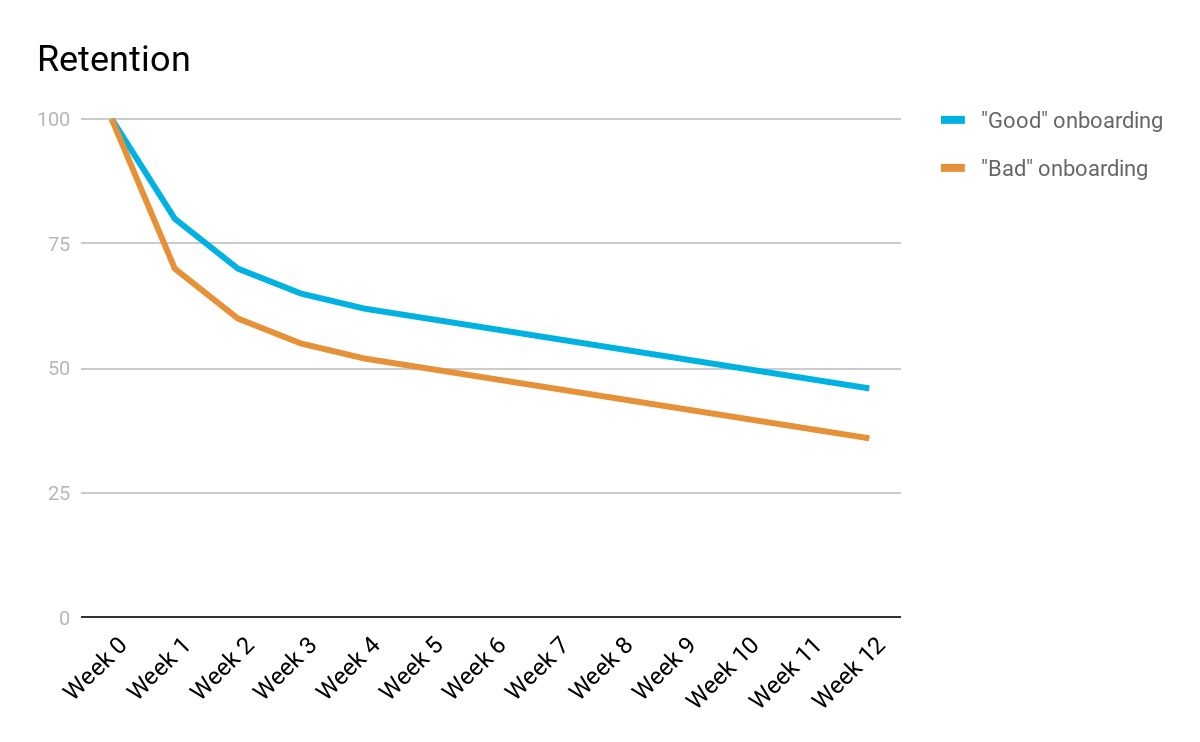The natural tendency of customers and vendors is to drift apart, not closer together. Let’s say it another way: The natural tendency of all your customers is to churn.
But is that true? Let’s play it out.
You make the sale, close the deal. Then you do nothing. What happens? I think we can all agree that on a long enough timeline, everybody quits, cancels, or lapses. On a long enough timeline, everybody churns. 100%.
Okay, maybe that’s overblown. Let’s say 99.9%.
And we see this play out in the data. This is a pretty standard SaaS retention chart. We almost always see the steepest drop-off during the onboarding process, an inflection point, and then a steady decline in users over time.

In a perpetual licensing model, that doesn’t really matter. You’ve made your margins on the initial deal. Every ex-customer is just another lead for a new sale. But in subscription, recurring revenue is the lifeblood of your company. You have to do something to retain and expand customers.
And we’re not just talking about logos, we’re talking about dollars. Partial churn, downsell, contraction. These are just as bad for business.
But you know that. That’s why you’re here. It’s the whole reason behind the customer success philosophy.
The question is, what do you do?
A retention strategy is really two parts when you break it down: insight and action.
It’s like that quote from The Matrix—there’s a difference between knowing the path and walking it.

And by that I mean you need to know what’s going to cause a given customer to churn and then you need to take the right actions to change their trajectory.
So you know that all your customers are at risk of churn, but you don’t know why they’re at risk. Until you know that, you can’t take the right action to prevent it.
So without any further ado, let’s take a closer look at seven of the most common reasons why customers churn and how to stop them. I’ll show you how to spot each one and give you a few steps you can take to prevent them.
Number One: No return on investment—no return at renewal
The most insidious churn cause is also one of the most common, and it’s the namesake of the customer success movement. A bit of context on this one: a lot of companies used to think about retention in terms of customer delight or customer happiness—in other words, customer experience. And that’s important, true, but it’s not necessarily correlated to retention. In fact, a great customer experience can mask underlying risk.
We think about it like this:
On the two-by-two, the x-axis is outcomes, or you could call it ROI or business value realization—is the customer achieving their desired outcome with your product or service? The y-axis is experience—does the customer like you? Are they happy with your company?
Ideally, we want everybody to be up here in the top right—achieving outcomes, having great experiences. And we never want to be in the bottom right—no ROI and they don’t like you.
But if your customers are here, achieving value while also having a poor experience, they’re usually not at risk of churn. They may detract you publicly, they may feel trapped, but they don’t want to give up the value they’re getting from your company. This could just mean there’s not a lot of choice in your market. This is where phone companies, ISPs and insurance companies live.
But where you really start to get into churn trouble is here—great experience, no ROI. Customers will churn but it will happen without warning, because they really like you. They may even advocate for you on their way out the door.
So how do you see this coming?
Warning signs: The biggest telltale sign of this churn cause is a decrease in usage or inactivity after signup.
Obviously this demands some kind of insight into usage. If you’re a SaaS company, you really should have access to this data. If not, you need to quantify what actions your customers take with your product to drive value—to get what they pay for—and figure out a way to track it.
But whether you have that kind of data or not, having a clear understanding of your client’s definition of ROI and the objective criteria they need to meet to achieve it is critical.
How to stop it: Yes, you need to be focused on improving product stickiness and driving adoption, but equally as important is reinforcing that ROI constantly. Are you sharing adoption numbers with your customers? Are you telling them in dollars how much your product or service is putting back into their pocket?
- Define ROI goals.
- Meet those goals.
- Report value delivery.
- Profit
Number Two: Stalled implementation
A beginning is a very delicate time. Customers are antsy to get started, but they can lose momentum easily. If customers don’t see value early, they can quickly become a churn risk.
Warning signs: If they don’t get the product operational on time. If they fail to see initial value soon enough.
How to stop it: If you remember that retention chart I showed you, the highest leverage moment is during onboarding. The smallest increase in adoption will result in the biggest difference in retention over the long term. Now, a lot of people think about onboarding as a limited engagement, but it’s actually ongoing. Training new users and reengaging old ones should be happening continously.
Find out what features are driving value and focus on deeping user adoption through training and broadening that use among the user base at your customer—do it early! And if you have a complex product, it helps to break up the implementation into smaller phases.
Number Three: Sponsor change
Not everyone who works at your customer cares equally about your product. You’ll have casual users, power users, champions, stakeholders, and people who don’t know about you at all. If your buyer, admin, or power user leaves the company, you’re in big trouble.
Warning signs: Your key contact goes dark.
How to stop it: Come up with an early warning system. Maybe even keep tabs on your sponsor’s LinkedIn. But most importantly, don’t put your eggs in one basket. Identify backup sponsors and train them and communicate with them to get to the point where your relationship isn’t dependent on any one person.
Number Four: Low product adoption
What were your customers doing before they had you? It’s easy to revert back to your old status quo if you run into problems with your current solution.
Warning signs: Have you had a drop-off in usage? Or maybe it’s just low across the board.
How to stop it: This is great white-space for collaborating more closely with your product team. Find out why your features aren’t sticky enough and look for in-product ways to reengage users and get them back into healthy habits.
Read the Essential Guide to Product-Driven Customer Success
Number Five: Product gaps
Just because your customer was happy and healthy a year ago, doesn’t mean they are now. If your product has been passed in key features or price by the market, you could be in trouble.
Warning signs: Your customer is asking for new features, enhancements, or asking you for a better price.
How to stop it: You need a system to constantly collect feature requests and feed them back into your Product team. I’m always surprised by how often CS teams aren’t really communicating with Product Managers. On the other hand, how well do you know your product roadmap? Are you communicating it to your customers through regular webinars and demos? Engaging your customers in the development process is a great way to deepen your relationship and get invaluable feedback from your biggest stakeholders.
Number Six: Performance issues
This is all about poor execution. Whether it’s a product issue, a support issue, a services snag—if you’re not executing well, your customers pay the price. And then you do when the renewal comes up.
Warning signs: You see an increased volume of unresolved support tickets or escalations.
How to stop it: This one’s tough because there’s a certain threshold of support tickets that is a sign of customer health, not risk. The more support tickets you get, the more your customer is engaging with the product—to an extent. If those tickets go unresolved too long, or if there’s just too many of them, it’s bad. Are you tracking support tickets and escalations? Do you know where your threshold is when it crosses that line between healthy and unhealthy?
Number Seven: The human factor
Customers are human! They’re made up of human beings and so is your company. If you’re reading this, you are a human being too. Sometimes humans do weird things or behave in complex ways for complex reasons. That a good thing! But it could also result in weird churn cases you don’t always understand.
Warning signs: You get negative feedback in a survey, meeting, or call—or online in a public review.
How to stop it: You are taking feedback, right? Don’t ignore it! You need to respond to it, take action to address it, and then close the loop by telling your customers what you did. There’s a huge gap between companies that ask for feedback and those who actually act on it. Lastly, are you working on your “soft skills”? Customer success is always going to be a human function, and having empathy and good communication skills is always going to be important.
Want 3 more churn causes? Watch the webinar version of this post!
This blog was 100% based off “Customer Success,” the book by Dan Steinman, Nick Mehta, and Lincoln Murphy. If you want to learn everything you need to know about customer success, you have to check it out.
